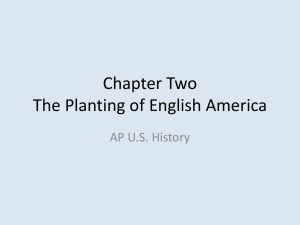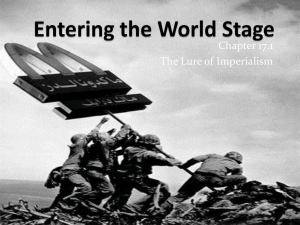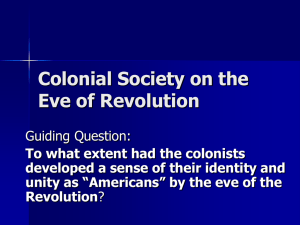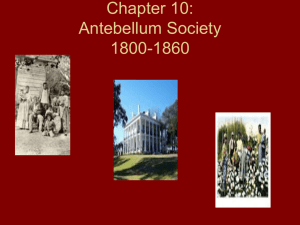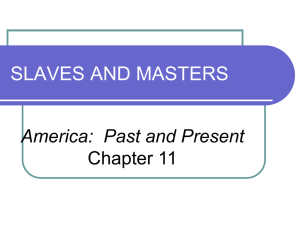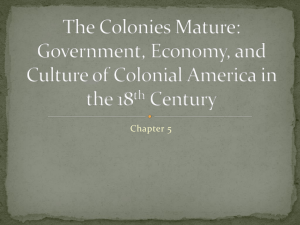Option A: Caribbean History
advertisement
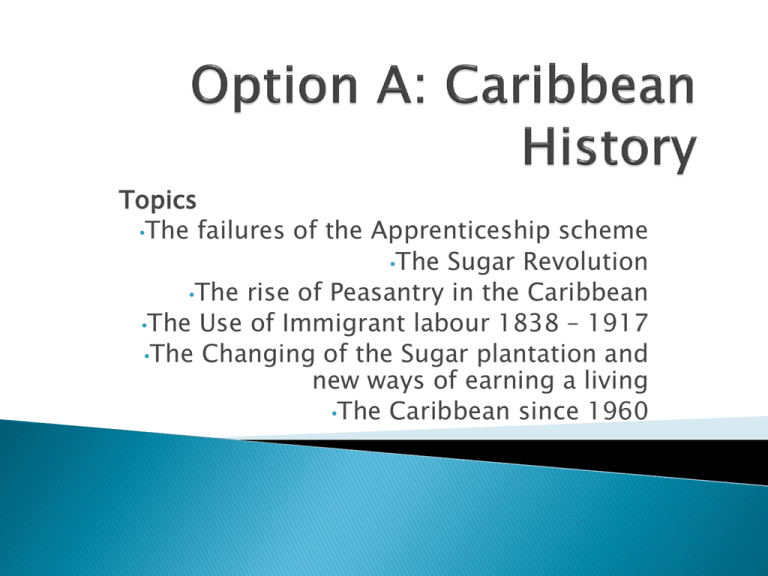
Topics •The failures of the Apprenticeship scheme •The Sugar Revolution •The rise of Peasantry in the Caribbean •The Use of Immigrant labour 1838 – 1917 •The Changing of the Sugar plantation and new ways of earning a living •The Caribbean since 1960 Looking ahead 1. Why did the colonial office think that apprenticeship was the first step to creating a free society? ◦ ◦ 2. ◦ 3. ◦ 4. ◦ 5. ◦ Because it gave apprentices the opportunity and time to learn skills necessary when they were free Because it gave the colonies time to develop the social necessities that were not in place before. Did the planters feel the same way? No, they saw this as an opportunity to expand free labour. How did the planters use apprenticeship regulations to serve their own ends? They were able to get more time out of apprentices and they could monitor the time spent off the plantations. Why did special magistrate have such a difficult time doing what was expected of the by the colonial office? Because they were paid such low wages that they could be easily bribed by the planters. Why did apprenticeship end in 1838? B/c the planters rather to end the scheme than adhere to the changes made by Richard Chamberline The Apprenticeship scheme: ◦ six year transitional period for both slaves and planters. ◦ It was made mandatory in Trinidad and British Guiana and optional in other colonies ◦ Only Antigua did not adopt it. Planters were afraid that slaves would leave the plantations so policing laws were passed and Special Magistrates where sent to the colonies to govern them. Unfortunately the were paid only 40 pounds per year and could be easily bribed by planters. The laws were made by the local assemblies and usually favored the planters; which made it very difficult for apprentices to stray from the plantations without a required license and permission. The fear remained between the Colonial Office and the planters that the mass movement of apprentices away from the plantation would led to the financial ruin of the colonies. Terms of the Scheme: ◦ Apprentices worked 40.5 hours per week before they were paid. ◦ Elders and children were free and still had to be taken cared of by the planters ◦ The Colonial Office hoped that the six years would be enough time to build schools, housing, hospitals, roads, etc. Punishment for Apprentices When found guilty for a violation the common punishment was the workhouse; which were under the control of the local parishes in the colonies. ◦ The usual form of punishment was the treadmill. ◦ In the work houses the laborers were required to wear chains, not even used in the last years of slavery. ◦ Females were often forced to shave their heads. ◦ On the plantations apprentices could have their rations cut or stopped altogether. Trinidad As the Governor as he read the Emancipation Act slaves jeered and the riot act was called. St Kitts and Montserrat There were many riots Jamaica Many apprentices ran away and had to be rounded up by the militias and returned to their plantations. British Guiana The Assembly assigned some apprentices as constables and used them to convince the others to maintain order There were very few honest magistrates, the few that existed included Richard Chamberline, who was key in ending the period. The magistrates were required to send monthly reports which contributed to ending Apprenticeship. In 1837, when recommendations were made to take away the work houses and eliminate flogging and the use of the treadmill for females there came a consensus that the Apprenticeship scheme should end completely in 1838. Rather than comply with the recommendations the planters preferred to end the scheme, hinging on the fat that they would still be able to control the movement of laborers through the licensing and ticketing system. The purpose of apprenticeship The ex-slaves opposition to apprenticeship The appointment of special magistrate The new police laws The close ties between the magistrate and planters The workhouses The control of the apprentice on the plantations Honest magistrates Ending apprenticeship. French Colonies Emancipation of slaves the French Caribbean that came into effect by way of the French revolution was maintained only in Haiti. Slavery was re-implemented in these colonies in1803. The country passed laws to end slavery again in 1818; however, between 1818 and 1831, more than 100,000 new slaves were shipped to the colonies. The reintroduction was accepted much like the Apprenticeship scheme in the British Caribbean: ◦ Martinique experienced disturbances several times between 1822 and 1834. Amelioration was also adopted and by 1833 and slaves had to be registered and branding and mutilation was outlawed. Victor Schoelcher, a French abolitionist travelled to the colonies in 1840 and determined that slavery should end. A secular movement, La Societe pour l’Abolition de l’Esclavage was formed in 1834. This group was more effective than any other Britain had seen. ◦ In 1836, they achieved the emancipation of every slave to set foot in France ◦ In 1838 a bill was drafted for the emancipation of slaves. ◦ In 1847, the society called for an immediate emancipation ◦ In 1848 a national petition was sent out This petition being more successful, led to the abolition of slavery in Martinique and Guadeloupe as well as Cayenne in South America and Reunion in the Indian Ocean at a compensation of about 50 francs per slave. In Cuba there became a decline in the tobacco and boom in sugar around the 1700’s. A rise in demand for the crop lead to demand for slaves. In1791, the Spanish slave trade was open and persons importing slaves would export any item duty free. By 1817, slaves made up more than two thirds of the population (224,000). Risks of slave rebellions were greater due to emancipation movement in British Caribbean which provided safe haven for runaways. Spain, during a 1815 Congress at Vienna, promised to end the slave trade in 1817 and signed a Reciprocal Search Treaty with Britain. Another agreement was made to abolish slavery in 1820, but the slaves continued to be imported at a rate of 10,000 per year. Anytime Spanish ships carried slaves they would carry an American flag to prevent begin searched. The manumission process in Cuba led that could prove that he was imported after 1820 could be liberated. Fear remained that emancipation would lead to allblack republics like Haiti. The pro-slavery groups in Cuba was considering joining forces with the United States. The British advocated for the abolition of slavery for two basic reasons: ◦ Spanish sugar had been outselling sugar from the British colonies. ◦ They wanted to keep Cuba out of the hands of the Americans The American Civil War broke out in 1861 and this lessened the concern. The Spanish monarchy was overthrown and replaced by an anti-slavery republic. During this same time, Cuba and Puerto Rico were also struggling for their independence which included plans for the emancipation. In 1865, the Spanish islands achieved Puerto Rico achieved the same in 1873 Compensation the planters totaled 35 million pesetas Cuba followed in 1886 with no compensation at all. 1. 2. 3. 4. 5. 6. 7. 8. 9. How long was the Apprenticeship scheme to last for field workers? Which British colony chose not to adopt the Apprenticeship scheme? How many hours were Apprentices required to work per week? Which group of persons were exempted from apprenticeships? List three things the Colonial office hoped to achieve during the Apprentice years. What was the response to the Emancipation act by Apprentices in Jamaica and Trinidad? What was the role of the special magistrate? Describe two ways in which Apprentices were punished. Who was Richard Chamberline and what role did he play in Apprenticeship? To an outsider looking in the British colonies, it would have appeared that all of them had the same problems. The islands that were large with small free slave population faced major labour as well as those problems with large free slaves who shunned the plantation labour as in the cases with Trinidad and Jamaica respectively. Trinidad resolved its problem with immigration whereas Jamaica refused to combat the problem the same way. During and after the apprenticeship period free village spontaneously emerged or through the agitation of missionaries. This movement has been credited with the development of a working class better know and “independent peasantry” or “yeoman farmers” which became the backbone of the West Indies. These villages were more common in Jamaica and Guyana. Jamaica The freed villages in Jamaica were modeled after the Maroon settlements established before the end slavery. They were positioned far away from the plantations. Since most of the freed African were not able to afford land, however there were a small few who were privileged. These persons usually purchased small plots, not usually adequate for farming. However, this was a means of keeping the plantation workers near the plantations. The majority who utilized the lands purchased through the churches in England. Before the end of slavery a Baptist missionary, William Knibb, encourage the apprentices to establish free villages. His goal was to ensure that ex-slaves to own their land as a part of the peasantry movement. He also encourage slaves that could save enough money to purchase their own land to settle on crown land. As a result of his support, he found little favour with the planters. He was not the only missionary to support the freed-slaves. The first free villages was built on land purchased by James Phillipo in 1835. In this settlement called Sligoville, there were 100 families. Sturgetown was built in 1838 by William Knibb and hosted 75 families. The Africans who were able to purchase lands during the Apprenticeship were much more fortunate than their counterparts. Not only were they able to gain proof of ownership but the lands were already cleared and very close to the markets. In Antigua, the establishment of free villages did not come until 1842 and this was through the lobbying of the governor Sir William Colebrook. His goal, like many others was to keep the freed African as agricultural laborers. His idea was first met with resistance from the planters who wanted to maintain control of the labourers, but was soon accepted after the threat of opening the Colony’ crown land to the freed. The planters also saw a financial opportunity in this as the freed men were willing to pay hefty prices for poor land. By the end of 1842 more than 27 independent villages had been established in Antigua. In Trinidad and Guyana, many of the planters compromised by dividing the front of their lands and sold them to workers. The desire for land opened up many opportunities for the exploitation of African workers. In 1840, the Governor of Jamaica had written the Secretary of State to complain about this matter. One example of which was the purchase of 283 hectares for 500 pounds by one Mr. Drummond of Jamaica. He divided the land and sold it to other planters, for five times what he paid. They then divided their plots and sold them to Africans for eight times what they paid. Rather than making them rich and happy the workers became heavy in debt and miserable. GUYANA In Guyana, ex-slaves had the good fortune of being able to establish cooperatives. This meant that large groups f them would pool their finances and purchase and entire plantations, while dividing the work equally, as well as the expenses and the profits. This was the case with the North Brook plantation were 89 individuals bought one share of the property in 1839. In 1852, the planters who had always been in opposition to the cooperative scheme convinced the governor to pass Ordinance 1which prevented the purchase of land by more than 25 persons. This was not a total hindrance, so Ordinance 33 was put into place which limited common ownership to 10 and required cash payment for the upkeep of the drainage. This then forced many of the cooperative members to leave their plantation in search of work for wages. Every attempt was made for laborers to leave the plantations. By 1861, more than 1/3rd of the Jamaican freed population made a living off the plantation with sixty-five thousand of them Owning small farms. By 1859, almost half of the Guianese population was completely or partly independent. The sugar duties Act was passed by the planters in order to make up fro their losses and changed the wages from 48 to 32 cents per day. The import duties were lowered and more laborers were encouraged to move away from the plantation. Small farmers not only grew food for their own consumption but sold some at market. This simple process became one leg in many steps that became a trade of “higgling”. The planters of the West Indies were more than happy for the initiation of the Immigration scheme as it came as a resolve to their immigration issues. This movement occurred primarily in the Windward islands, Barbados, Trinidad and Guyana. The British Government, although not completely behind the concept of the immigrant labour, as it known as the “New Slavery”, stood behind the planters as the labor issue remained and they had to maintain the economy, though sugar. It is not to say that the Government did not receive pressure form the Anti-Slavery Society. In order to resolves this matter, in 1838 James Stephen was given the role of drafting the Immigration Scheme into the emancipation Act. There were at least five groups impacted by the scheme: ◦ ◦ ◦ ◦ ◦ Europeans Madeirans and Maltese Free Africans Chinese and Indians Europeans European labour was primarily imported to Jamaica. During the years of Apprenticeship thousands of Scots, Irish and Germans migrated to the islands. Many of whom would not work because the work that they were issued they considered the work of the Blacks. Those that managed to remain died out due to a lack of immunity to the tropical diseases on the island. Another attempt at European labour was initiated in 1841. Some of whom also went to St. Kitts with practically the same results, death or voluntary repatriation. Madeirans and Maltese Persons from island European islands of Madeira and Malta had been cultivating sugar from the Renaissance period. Persons from this area were already experienced in sugar cultivation. They were drawn to the islands buy the higher wages, four pence per day. The Maltese immigration was very “stop and go” as the scheme had been halted in 1839 and then again in 1848 later it was restarted in 1841. During this time the treatment of the Madeirans and the Maltese was investigated and although the scheme was allowed to commence in 1850, to remained on a much smaller scale. The importation of free Africans to the Caribbean began in 1841. This group of persons came from; Sierra Leone, the Kru Coast, St. Helen or were rescued from slave ships. Some of whom were or were the descendants of the Maroons who were deported in 1796. This scheme was short lived some obvious reasons [1841 -1862]. ◦ The same private ships that often transported slaves transported the emigrants, which gave a feeling of slavery. ◦ The emigrants from West Africa were lured to the area under false pretenses of labour. Chinese Immigration was known to last for a long period of time, but had the most problems. Most of these emigrants went to Cuba with a few going to the West Indies. Trinidad attempted to import the Chinese at the threat of abolition in 1809. When this small group arrived they either refused to work or were unsuited for the work required. Some of the problems associated with this scheme were: ◦ The Chinese government opposed it because it was said to hurt national pride. ◦ Only Chinese men were allowed to immigrate and it created a sense of jealousy between the locals and the Chinese. ◦ It was most expensive to impart them from their homes, 25 pounds. In 1837, John Gladstone, the owner of British Plantation in British Guiana, applied for permission to import Indian labourers to the Colonies. In 1838, almost 400 labourers flowed into the colonies, but upon investigation it was found that many of them died. By July of 1838, the immigration had been halted. Some of the Indians had been abused while other was not paid what they had been promised. Immigration again resumed in 1844 and lasted until 1917. The colony of British Guiana had been spending in excess of 50,000 pounds per year on the imports. The British government felt compelled to continue the scheme as both countries were its colonies. Guiana’s experienced a close call to bankruptcy and the mistreatment of the "East Indians” as they were called. By the end of the scheme in 1917 more than 416,000 Indians had arrived in the West Indies. Classwork: 1. What similarities and differences existed between the different immigration schemes? Make note of the times and reason for the immigration, and the conclusion of the various schemes. 1. 2. 3. 4. Describe how Ghana became a successful independent nation and how it declined. Describe how Mali became a successful independent nation and how it declined. Describe how Songhai became a successful independent nation and how it declined. Discuss the similarities of the success and failures all three states and give two mutual causes of their decline. The initial onset of the immigration required only that the labourers arrive to the colony and work. The planters began paying for the passage and then required that they have contracts signed upon the arrival. In 1848, The Government gave planters permission to have contracts signed at the port of embarkation. The original contracts were signed for only one year. In 1848, the contracts were extended to three years and finally in 1863, the contracts were extended to five years, the period of time which the planters had been vying for. Within the contracts were specifics as to the hours and days that the labourers were to work. N.B. Research and be prepared to explain the labour conditions of the immigrant labourers. Objective: The economic and social impact of the Immigration policy on the West Indies There is much controversy about the actual impact of immigrant labour on the sugar industry post emancipation. For the most part, most of the islands experienced a boom in the overall profits and production by the end of the 1800’s early 1900’s, however; there were other factors that need to be taken into consideration. By 1848, the sugar production of British Guiana had fallen to only 40% of the levels they existed prior to emancipation. By the end of the 19th century, the levels had drastically risen to 250% of what existed before slavery was abolished. In Guiana it should have also been taken in to consideration that substantial numbers of land was sold for the cultivation of sugar had well as there had been improvements in the mechanization of the process of producing sugar. Trinidad had practically the same response. Although, there had never been a slump in the sugar production because the wages had remained high as well as the conditions were good. By the end of the century the levels were four times greater than before emancipation. The island colony of Barbados imported no immigrants labour faced an increase in the output sugar of more than 250% by 1848. To the same effect the levels decreased to 20% of the pre-emancipation levels by the end of the century. It should also be noted that Trinidad suffered from the exhaustion of the soil as well as it lacked mechanization in the process. Both Grenada and St Vincent had substantial amount of immigrants labour; however, in Grenada, the entire industry ended before the end of the century while in St Vincent they operated at about half of the preemancipation numbers. The immigration schemes introduced completely new cultures into the West Indies, that for the most part remained isolated. Asian were either Hindu or Muslim; 86 and 14% respectively. The Indian were noted for their cultural segregation the following are several reasons; 1. The Indians were linked by strong kinship 2. The immigration schemes kept them separated. 3. When the Indians were out of indentured servitude, they remained in agriculture and established isolated Indian village which also grew rice, cocoa and sugar cane. 4. The Indian and Africans despised each other. The Hindu and Muslim religions were despised by the Africans and the Indians hated the “lose morals and polygamy” of the Africans 5. Hindus Indians spoke only Hindi and maintained this, while refusing to send their children to school for fear of them begin converted to Christians. Despite the resistance, the culture remained string within the region and today has been better integrated. The factors of success of the Plantations after Emancipation Island British Guiana Labour Soil/Topography Mechanization 1. Why did the British West Indian colonies turn to immigrant labour schemes after emancipation? 2. What hardships did the indentured labourers faces in the British West Indian colonies after 1834? The Decline of Sugar Production after 1838 Objective: To describe the cause and impact of the decline of sugar in the British West Indies The Napoleonic wars pushed Britain to the forefront as a monopoly in the sugar industry despite the inflated prices. N.B. What was the cause and outcome of the Napoleonic wars? What countries were involved? This was the only period of prosperity as competition from the other sugar producing countries leveled the playing field. The problems for the English colonies were many and included; ◦ The labour problems as a result of the abolition of the slave trade. ◦ The price of slaves rose ◦ The increasing price of sugar as a result of the labour problem. ◦ The overall emancipation of slaves made this difficult time even more so. ◦ The West Indies had now been receiving great competition from the colonies on India and Mauritius. The West Indies had enjoyed low rates on the duty of sugar, but this privilege was also extended to Mauritius in1825 and India in 1836. At the emancipation of Slavery, the sugar barterbased economy was not converted into a cash economy. The Apprenticeship should have been sufficient time for this adjustment, however, the challenge of the cash exchange proved extremely difficult an adjustment. The apprenticeship scheme should have been enough time only in theory, but in fact there was very little money in circulation and most of the bills came out in 1838. The slave’s wages had a vast range that could mean that planter paid about 20 pounds for the labour of 100 slaves in a place like Barbados, but may have paid 60 pounds in a place like Trinidad. The wage bill led to the establishment of the Planters’ bank in Jamaica in 1837 and the West Indian bank in Barbados in 1840, and both of which had branches on the other islands. The capital for the banks was endorsed by merchants in Liverpool and London. Based on the strength of their crops, credit was extended to the planters. The process appeared to be good business as long as the crops were successful. When crop prices began to fall, partially due to the Sugar Equalization Act of 1846, it led to the collapse of many of the West Indian banks, due to the customer’s inability to pay. Foreign Countries had cut their production costs and were able to produce and sell sugar for substantially less than the British; English sugar 22shillings per cwt, Cuban Sugar 12shillings per cwt and Louisiana Sugar, 15 shillings per cwt. To combat the prices, British Guiana, increased in acreage for sugar plantations, which increased production. The best resolution, which British competitors had adopted, was the mechanization of the production process which would have lead to lesser labour costs. This kind of technology would have required capital in order to purchase, however, these island colonies were finding difficulty find more investment in such a risky market. A final challenge of the Planters was the 4.5 % export rate of the sugar that was required to be paid, this was ultimately removed during a period of desperation in 1838, but ultimately the planters still paid more for any imports coming to the island. The idea of free trade was only established around 1776, with the theory of economist Adam Smith, his ideas along with those of David Ricardo, the author of "Principles of Political Economy and Taxation" and the boom caused by the Industrial revolution in Europe motivated the British Colonies toward the concept of free trade. Before the system of trade had been organized around the barter system with planters receiving credit for whatever crops were provided. The free trade system would allow for the cheap purchase of raw materials with capitalism governing the open market, while duties remained absent. Many British persons lobbied for the free trade as the cost of sugar had risen substantially and the British Government and people had been subsidizing the industry in the West Indies at a sum of £2,500,000 to £4,500,000 per year. In 1849 the Navigation acts were repealed and the British Empire entered into free trade. Many planters protested and revolted that this move would lead to the end of the Sugar Industry and in fact the period of 1846 to 1854 was a very critical to the industry’s survival. The foreign competition caused such threat to the British planters that the Act as it was implemented gave leeway to the planters and allowed them a five year grace period in order to adjust their prices before free trade truly began. 1. What was the function of a special magistrate? 2. How apprenticeship schemes responded to by exslaves in Jamaica? 3. How many hours were in average work week for slaves? 4. When were slaves to be paid for work completed? 5. Who was James Phillipo? 6. What does the term "higgling or haggling" mean? 7. What was the cause of the fall of the Planter's Bank 8. List three groups of immigrants imported to assist in the labour shortages 1. 2. 3. 4. 5. 6. 7. 8. 9. 10. 11. 12. 13. Define the terms of the apprenticeship scheme. When it was set to begin and end? Which colony did not adopt the scheme? What expectations did the Colonial office have of the scheme? Note two examples of how the scheme was rejected? Who was considered and “architect of freedom”. What was the role of this person? List three forms of punishment for unruly apprentices. What recommendations did Richard Chamberline make to the Colonial office regarding the punishment of apprentices? What was the response of the planters? Explain two ways in which planters were able to control the apprentices outside of punishment. Compare the reintroduction of Slavery in the French colonies to that of the Apprenticeship scheme in the British colonies. Compare the movement of the Society for the Abolition of Slaves [French] to that of Quakers. What compensation did the French crown give to the planters for each freed slave? What were the terms of the Reciprocal Search Treaty and when was it signed? When was slavery abolished in the Spanish colonies, and then Cuba? 1. 2. 3. 4. 5. 6. 7. 8. 9. 10. 11. 12. Which two British colonies did hire immigrant labour? Generally speaking, free villages were as a result of agitation from which group? Who were considered “yeoman famers”? What became the model for African villages in Jamaica? Why were William Knibb and James Phillipo not popular with planters? When was Sturgetown built? When was Sligoville developed? When did free African Villages become popular in Antigua, and under whose influence? Which colony was able to develop cooperatives? What were two hindrances to the maintenance of these cooperatives? By 1861, what percentage freed Jamaicans lived off of the Plantations? What changes in wages did the Sugar duties Act produce? 1. 2. 3. 4. 5. 6. 7. 8. 9. 10. 11. 12. In which parts of the West Indies was the movement of the immigration scheme widely accepted? Why was the immigrants’ scheme considered new slavery? What role James Stephen play in the Emancipation Act? What was the result of the immigration of Europeans to Jamaica? What factors drew West Indians planters to import Madeirans and Maltese workers and what drew these immigrate to West Indies? From which areas were labourers emigrated? Why did the use of African labour not continue for an extended period? List the three problems that were faced with importation of Chinese labor? What role did John Gladstone play in the emigration of Indians? What became the fate, of many of the first Indians? What was relationship between Africans and East Indians in the West Indies? Why Indians did chose not to send their children to school?
